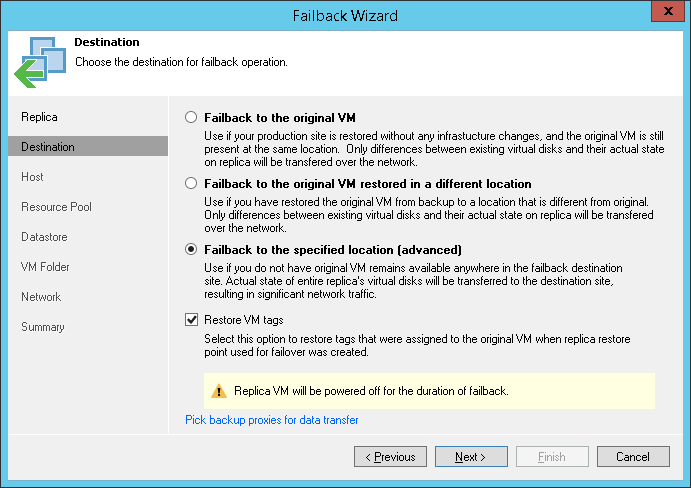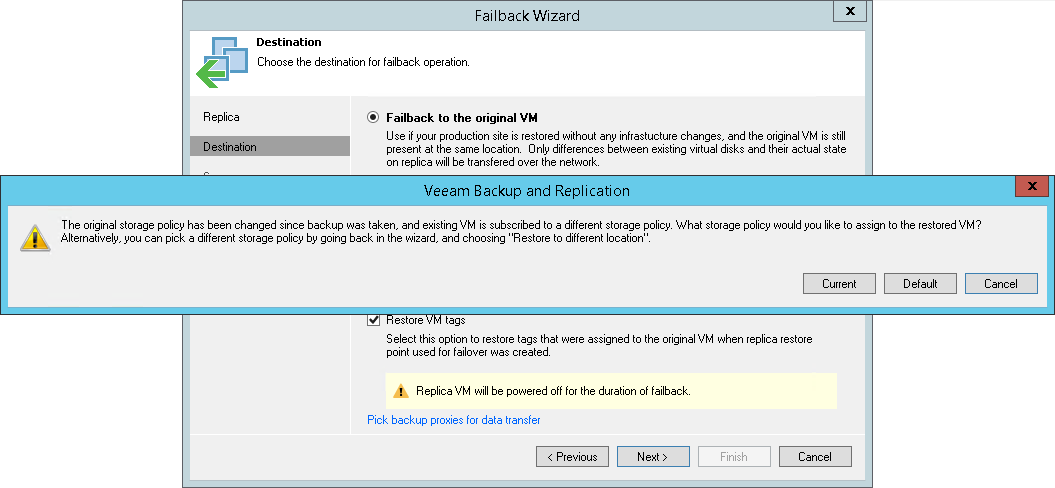 This is an archive version of the document. To get the most up-to-date information, see the current version.
This is an archive version of the document. To get the most up-to-date information, see the current version.Step 3. Select Failback Destination
At the Destination step of the wizard, select the failback destination and backup proxies for VM data transport during failback.
- Veeam Backup & Replication supports three possible failback destination variants. Note that the Failback wizard displays a different set of steps for every failback variant.
- Select Failback to the original VM if you want to fail back to the original VM residing on the source host. Veeam Backup & Replication will restore the original VM to the current state of its replica.
If this option is selected, you will pass to the Summary step of the wizard.
- Select Failback to the original VM restored in a different location if you have recovered the original VM from a backup in a new location, and you want to switch to it from the replica. In this case, Veeam Backup & Replication will synchronize the recovered VM with the current state of the replica.
If this option is selected, you will pass to the Target VM step of the wizard.
- Select Failback to the specified location if you want to restore the original VM from a replica – in a new location and/or with different settings (such as VM location, network settings, virtual disk and configuration files path and so on).
If this option is selected, you will need to complete all further steps of the wizard.
If you fail back to the original VM or the original VM is restored in a new location, only differences between the existing virtual disks and their state will be transferred to the original VM. Veeam Backup & Replication will not transfer replica configuration changes such as a different IP address or network settings (if replica re-IP and network mapping were applied), new hardware or virtual disks added while the replica was in the Failover state.
If you choose to perform advanced failback, the entire VM replica, including its configuration and virtual disks content, will be restored in the selected location.
- Select the Restore VM tags check box if you want to restore tags that were assigned to the original VM, and assign them to the restored VM. Veeam Backup & Replication will restore the VM with original tags if the following conditions are met:
- The VM is restored to its original location.
- The original VM tag is still available on the source VMware vCenter Server.
- Click the Pick backup proxies for data transfer link to select backup proxies for data transfer during failback. In the offsite replication scenario, you must select one backup proxy in the production site and one proxy in the DR site. In the onsite replication scenario, you can use the same backup proxy as a source and target one.
- In the Choose backup Proxy section, click Choose to assign a backup proxy. You can assign backup proxies explicitly or instruct Veeam Backup & Replication to select backup proxies automatically.
- If you choose Automatic selection, Veeam Backup & Replication will detect backup proxies that are connected to the source datastore and will automatically assign optimal proxy resources for processing VM data.
VMs selected for failback are processed one by one. Before processing a new VM in the VM list, Veeam Backup & Replication checks available backup proxies. If more than one backup proxy is available, Veeam Backup & Replication analyzes transport modes that the backup proxies can use, the current workload on the backup proxies to select the most appropriate resource for VM processing.
- If you choose Use the selected backup proxy servers only, you can explicitly define backup proxies that must be used for data transfer. It is recommended that you select at least two backup proxies to ensure that failover is performed should one of backup proxies fail or lose its connectivity to the source or target datastore.

Restoring Storage Profiles
If the replicated VM was associated with the storage profile, in the failback to original location scenario, Veeam Backup & Replication will associate the restored VM with this storage profile.
When you click Next, Veeam Backup & Replication will check storage profiles in the virtual environment and compare this information with the information about the replica storage profile. If the original storage profile has been changed or deleted, Veeam Backup & Replication will display a warning. You can select one of the following options:
- Current — the restored VM will be associated with the profile with which the original VM in the production environment is currently associated.
- Default — the restored VM will be associated with the profile that is set as default for the target datastore.
- Stored — the restored VM will be associated with the profile that was assigned to the original VM at the moment of replication.
For more information, see Storage Profile Restore.
